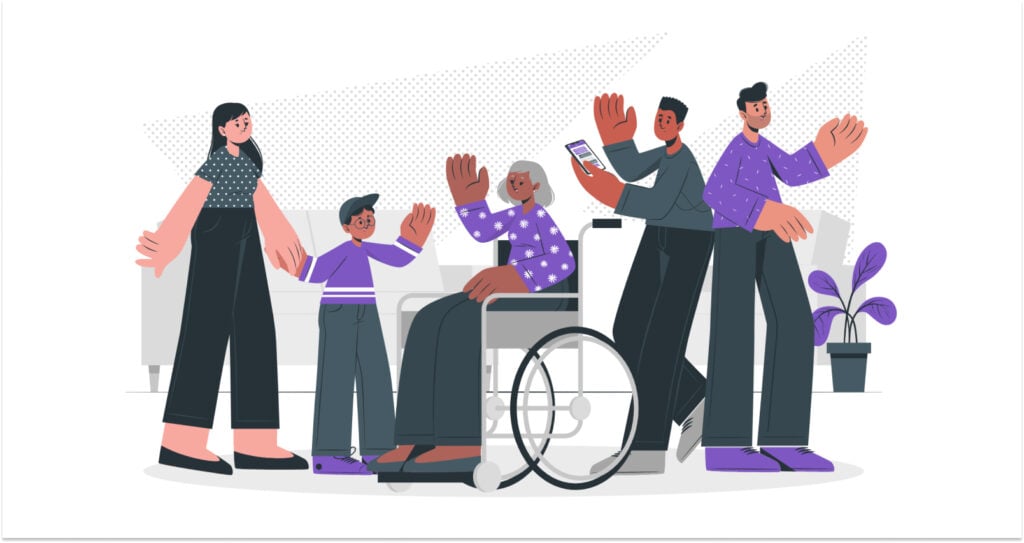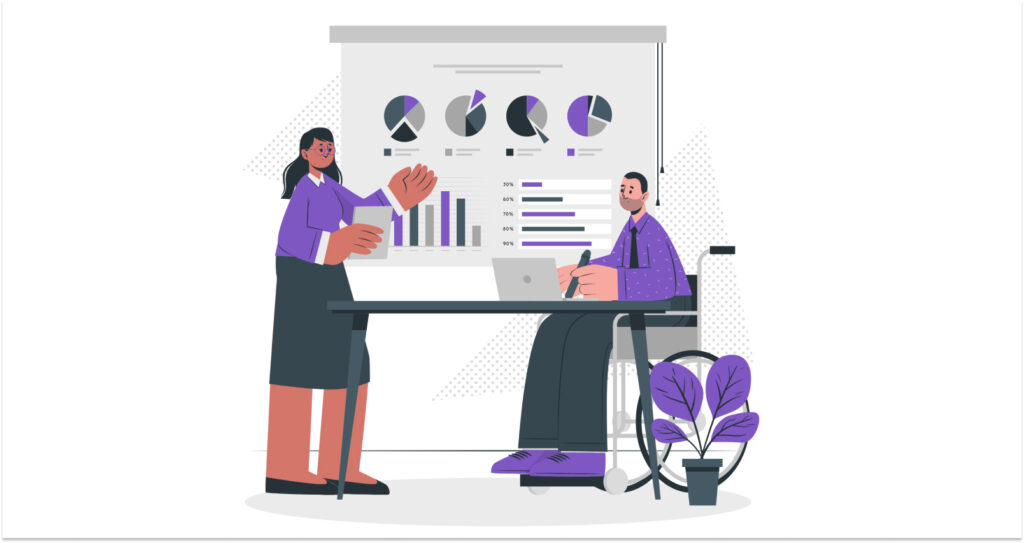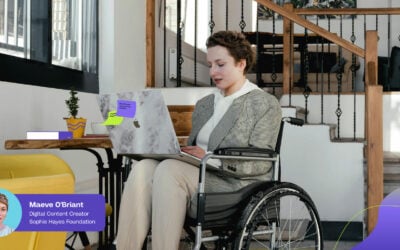
Over one billion people in the world live with some form of disability. In 2022, that’s an eighth of the population. Yet disability inclusion in the workplace remains a persistent problem in everything from hiring practices to office spaces.
Let’s talk about why ensuring accessibility is important.
What is ‘disability’?
According to the CDC, a disability is “any condition of the body or mind (impairment) that makes it more difficult for the person with the condition to do certain activities (activity limitation) and interact with the world around them (participation restrictions).”
Disabilities come in many variations and can affect a person’s vision, learning, memory, hearing, mental health, movement, and even social relationships. People with disabilities are not a homogenous group — they are diverse, and no two people have the exact same experiences.
Even two people with similar conditions could still have drastically different life experiences. On the other hand, one person could have multiple disabilities!
Some disabilities are ‘visible’, while others are ‘invisible’.
A visible disability is one that has a ‘visually’ observable presence, like cerebral palsy. Invisible disabilities are those that don’t necessarily manifest in the physical form or aren’t immediately apparent, such as autism.
But remember, this isn’t a strict dichotomy as sometimes, visible disabilities can affect people in invisible ways and vice versa.
Disability can be caused by a number of things. People can be born with a disability (congenital) or develop a disability later in life, for example, through a sudden illness. Environmental factors play a heavy hand, too, such as pollution, and so do trauma and abuse.
In addition to disabilities, there is a category called ‘neurodivergence’, which is a condition where the way somebody’s brain works is different from the ‘norm’.
While there is some debate over whether forms of neurodivergence can be categorized as disabilities or not, there is much overlap in the sense that both people with disabilities and neurodivergence experience discrimination in society.
Another point to take into consideration is the overall discourse on the term ‘disability’. Over the years, there have been many terms introduced to avoid saying ‘disability’, i.e., ‘special needs’ or ‘differently-abled’, etc., that puts the onus on the person with the disability.
Many activists argue that these terms either state that the person has ‘special’ needs that are an extra step everyone else has to begrudgingly take or that the person must prove their competence in order to have their value acknowledged.
While some people prefer not to refer to themselves as ‘disabled’, others prefer calling themselves ‘disabled people.’ On the flip side, there is also the argument about whether people can call others ‘disabled people’ or whether they ought to use ‘people with disabilities.’
While it is usually recommended for abled people to stick to the latter when speaking on the topic, people with disabilities highlight why ‘disabled person’ is more accurate for themselves.
A person can just appear with a scarf, but a person doesn’t just appear with a disability. Disabilities aren’t something that a person can simply forget about or take off at the end of the day. If we have a disability, it is a part of our everyday life.
We also recommend giving this wonderful piece by writer Joanne Limburg titled ‘Am I disabled?’ a read when you have a minute!
Disability inclusion
Disability inclusion is a way of ensuring that people with disabilities are not discriminated against and are included and celebrated for who they are. In order to do this, we must look beyond simply saying “we are inclusive of disabilities”.
People with disabilities face many obstacles, and disability inclusion takes steps to eliminate those obstacles. Take for instance sports. If a group of friends want to play basketball but don’t want to or can’t include their friend directly due to their disability, that’s a form of exclusion.
This form of disability exclusion may not always be malevolent and may often stem from ignorance, but the effects it has can have lasting and detrimental consequences on the affected person.
Making space for people with disabilities to participate in social activities in a way that embraces their presence and isn’t meant to show pity is a not-so-radical but highly effective form of disability inclusion.
But the issue isn’t as simple as ‘exclusion’ versus ‘inclusion’.
Tackling ableism
Implicit bias against people with disabilities is a pervasive issue even in modern-day society. A study of 300,000 participants between 18-90 of age conducted between 2004 and 2017 found that ‘implicit bias from respondents increased over time and with age.’ This highlights that instead of becoming more inclusive of people with disabilities, they started expressing less favorable attitudes towards them.
This is why the term ‘ableism’ and its effects need to be discussed.
Access Living defines ableism as, “the discrimination of and social prejudice against people with disabilities based on the belief that typical abilities are superior.”
They go on to state, “at its heart, ableism is rooted in the assumption that disabled people require ‘fixing’ and defines people by their disability. Like racism and sexism, ableism classifies entire groups of people as ‘less than,’ and includes harmful stereotypes, misconceptions, and generalizations of people with disabilities.”
Ableism can be categorized into two major groups: physical ableism, which is hatred and/or discrimination expressed towards individuals with physical disabilities, and sanism, which does the same towards those with cognitive disabilities or mental health conditions.
If biases, prejudices, and discrimination are targeted at a person with a disability, this is ableism.
Ableism comes in many forms and can be found in pretty much every medium. For example, in comedy — both on stage and off — disabilities are often used as punchlines to jokes. But it doesn’t stop there.
Ableism has real-life consequences that further increase the barriers that people with disabilities face — particularly in terms of overcoming stigma and being able to navigate society with more ease.
While there are definitely ways to address ableism and other forms of disability discrimination in the home, at school, or in social settings, what happens when disability exclusion happens in the workplace?
Disability in the workplace

Previously, we highlighted how over a billion people live with some form of disability. In addition to this, there is a strong correlation between disability and poverty.
Poverty doesn’t exist in a vacuum and is often not caused by a single factor, so there is no single, swooping solution to it. Consider generational poverty, which is a complex and difficult situation to tackle, as it contributes to not just one person’s impoverished condition but is linked to everyone closest to them.
According to the World Bank, “Persons with disabilities are more likely to experience adverse socioeconomic outcomes such as less education, poorer health outcomes, lower levels of employment, and higher poverty rates.
“Poverty may increase the risk of disability through malnutrition, inadequate access to education and health care, unsafe working conditions, a polluted environment, and lack of access to safe water and sanitation. Disability may also increase the risk of poverty, through lack of employment and education opportunities, lower wages, and increased cost of living with a disability.”
What then for those who’ve beaten the odds and managed to secure employment?
Unfortunately, discrimination against people with disabilities is far too common in the workplace.
Wenzel Fenton Cabassa, P.A., a Florida-based employment law firm specializing in workplace discrimination, wrongful termination, retaliation, bullying, and more, provided a set of vital 2022 Employment Discrimination Statistics.
Employment discrimination is one of the more common employment law violations. Of these cases across the USA, discrimination against people with disabilities accounts for around 36.10%. This is followed by racial discrimination, at 32.70%, and sex-based discrimination, at 31.70%.
Such workplace discrimination can manifest in many ways, from subtle to explicit.
For example, a company could have an inclusive policy on disabilities in the workplace, but their office may be an inaccessible environment. They may not have a wheelchair ramp or an elevator. This presents barriers for people with mobility-related disabilities, like wheelchair users.
Inaccessibility hinders their chances of being active participants in the workplace, both professionally and socially.
Additionally, the office may be inaccessible in other ways. If an employee is immunocompromised and they have no option but to come to work in the middle of a dangerous pandemic or epidemic, they will be putting themselves at fatal risk.
Not having remote options for either socialising or working is actively exclusionary against these individuals. While these may not seem so overt, things can (and often do) get explicitly uncomfortable for employees with disabilities.

Why employers should do better
For those who aren’t disabled, improving disability inclusion may seem like a one-sided transaction. While taking this step shouldn’t be subjected to quantification of its benefits, this is still not the case.
Simply put, disability inclusion is beneficial for everyone.
Having a disability doesn’t mean a person lacks value, but it also doesn’t mean they must make significant contributions to society to be considered valuable. But the truth is that people with disabilities have been contributing to society in many ways for many centuries.
The issue isn’t what or if they can ‘work’ — the issue is that those who do want to work are rarely offered the opportunity to do so.
While it is recognized that economic growth can lead to increased employment opportunities,
the code outlines best practices which enable employers to utilize the skills and potential of people with disabilities within existing national conditions.
The ball is now in the court of the employers.
An ILO report on Managing Disability in the Workplace highlighted, “It is increasingly apparent that disabled people not only have a valuable contribution to make to the national economy but that their employment also reduces the cost of disability benefits and may reduce poverty. There is a strong business case for employing people with disabilities since they are often qualified for a particular job.”
It also highlights that employers are, in fact, gaining multiple advantages by employing people with disabilities since “valuable expertise acquired on the job and through work-related training is retained”.
As Understood.org highlights, some benefits include higher retention rates, increased productivity, access to an untapped talent pool, and unique new perspectives to improve existing processes.
It further stated, “Many organizations and their networks – including employers’ and workers’ organizations and organizations of persons with disabilities – are contributing to facilitating the employment, job retention and return-to-work opportunities for disabled persons.”
Improving inclusion
It doesn’t start and end at hiring more people with disabilities, though. There has to be a feasible, inclusive policy that is put into practice.
We constantly see companies putting out policy statements on how inclusive they are of disabilities, but the reality of the situation may not be so.
In order to truly improve inclusion, employers must address the areas where they’re lacking and take the necessary steps to grow past them.
Safe spaces
One of the most important steps a company must take is to provide a space for employees with disabilities to exercise their rights free from retribution.
Often when encountering ableism, employees with disabilities would rather keep silent than speak up. This leads to a toxic workplace environment that will only make it difficult to retain your employees.
Try to understand
It’s not enough to simply create a space, it needs to be built on understanding and respect.
For example, if you have a team member who is autistic and struggles with gaze aversion, but you constantly criticize them for not making eye contact, that’s not right.
Additionally, people with disabilities are often criticized for not doing things everyone else thinks are ‘normal’, when most of the time, it’s not that they don’t want to, but that they can’t.
Ask them
You’d be surprised by how many misunderstandings could be avoided by simply communicating with people.
For example, if you’re worried that you might be making the work environment uncomfortable for a colleague with a disability, you should just communicate this to them. Most of the time, they’ll be more than ready to help you understand how you can help!
Set an example
The sad reality is, not everyone is going to be accommodating. They may view it as too much work or unnecessary, but that doesn’t mean you can’t make a positive impact! Even one person putting in a little extra effort to make the workplace welcoming can cause a ripple of positivity.
This is especially powerful when the person setting the example is higher up the organizational hierarchy. A leader leads, and that’s exactly what you must do if you want to improve diversity and inclusion in your workplace.
Finally, an important point to keep in mind is that inclusion doesn’t come from tolerance. It comes from understanding, embracing and celebrating diversity! So remember, open hearts and open minds will make the world a better place for all of us! Happy International Day of Disabled Persons.



